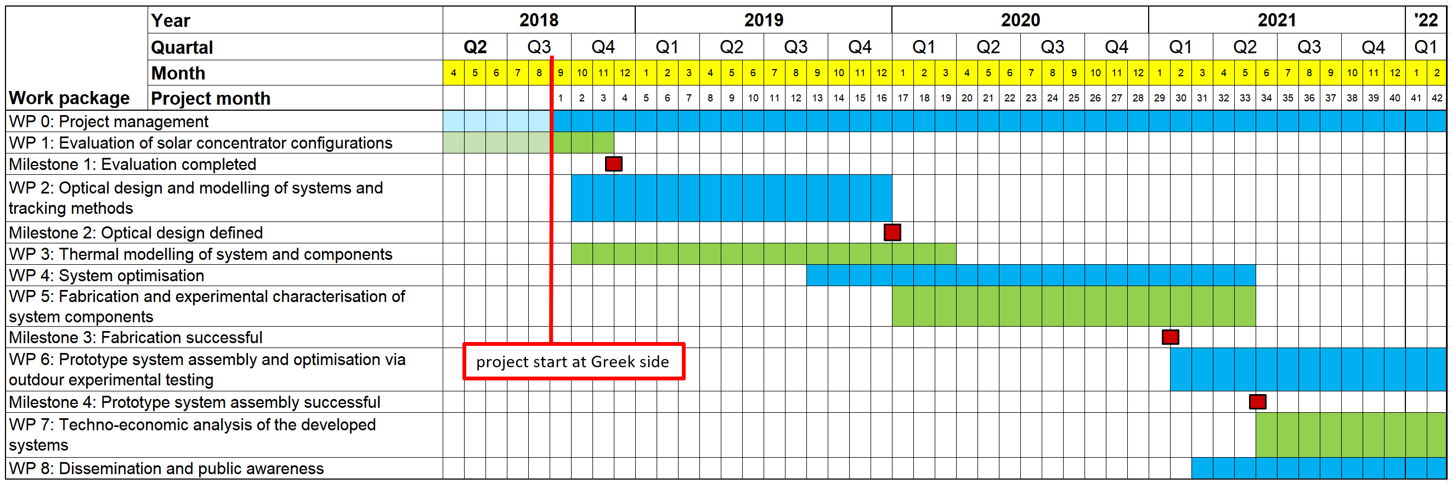Plan
Our work schedule
The proposed project activities and their associated dependencies are summarized below.
WP0. Project Management
This activity aims at ensuring that project objectives are adequately achieved, on time and within the estimated budget. It requires coordination of all work developed, overseeing the tasks and work packages, ensuring the development and testing of deliverables, and also reporting to the EC. Each work package will also have a designated leader.
WP1. Evaluation of solar concentrator configurations
Solar concentrator configurations for optimized integration of the system in industrial and commercial buildings will be reviewed and evaluated. Solar thermal components and materials will be assessed in terms of suitability for medium temperature operation, cost and ease of application in building integrated systems.
WP2. Optical design and modelling of systems and tracking methods
Based on the evaluation of activity 2, optical components for systems will be designed and modeled to evaluate optical performance. Three dimensional simulations will be carried out for different installation configurations. Tracking methods suitable for implementation by the designed systems will be developed.
WP3. Thermal modelling of system and components
The thermal performance of the designed systems and their individual components will be modelled to assess their suitability in achieving the performance targets in the medium temperature range. Using predictions (from activity 3) of solar radiation collection efficiency and expected effective concentration levels on the tracking absorber, the thermal performance for different installation scenarios will be investigated.
WP4. Systems optimisation
Findings from the optical and thermal analysis (activities 3 and 4, respectively) and the developed tracking methods (activity 3) will be used to optimise the designed systems for 50% thermal efficiency target at 150°C operating temperature to use the medium temperature heat for space cooling applications and offer the relative advantages easy integration in industrial buildings, and production of low temperature heat.
WP5. Fabrication and indoor experimental characterisation of system components
Components of the systems will be fabricated by the SME and industrial project partners. The fabricated components will be tested in an indoor controlled environment. Thermal testing of the fabricated system components will be carried out to ensure that they have reliable and efficient operation in the medium temperature range and can tolerate extreme operating conditions. Cross-validation of the test results with the thermal modelling will take place to predict realistic thermal performance under different operating scenarios.
WP6. Prototype system assembly and optimisation via outdoor experimental testing
Prototype systems will be assembled for outdoor installation and experimental characterisation in Greece. Intrusive experimental testing will take place to determine component and overall system performance in realistic conditions. System behavior with absorption chillers will be investigated.
WP7. Techno-economic analysis of the developed systems
The techno-economic analysis of the developed systems will consist of:
- Performance analysis
- Design analysis
- Cost analysis
- SWOT analysis
- Life cycle product analysis
- CO2 offsetting analysis.
WP8. Dissemination and public awareness
A project Web site will be set up that will allow up-to-date information about the project status and outcomes to be available to the general public, stake-holders and project partners. Confidential information and data will be stored in a restricted area, which will be accessed via user authentication. The following table shows the time table with 3 milestones. Other activities will include:
- Production and dissemination of documents and awareness raising material for likely users and other stakeholders, technical staff, policy-makers and partners as well as the general public.
- Submission of research papers to internationally recognized journals and conferences, to disseminate knowledge within the scientific community.
- Presentation of the system in trade literature.
The work packages will be implemented according to the following timetable
